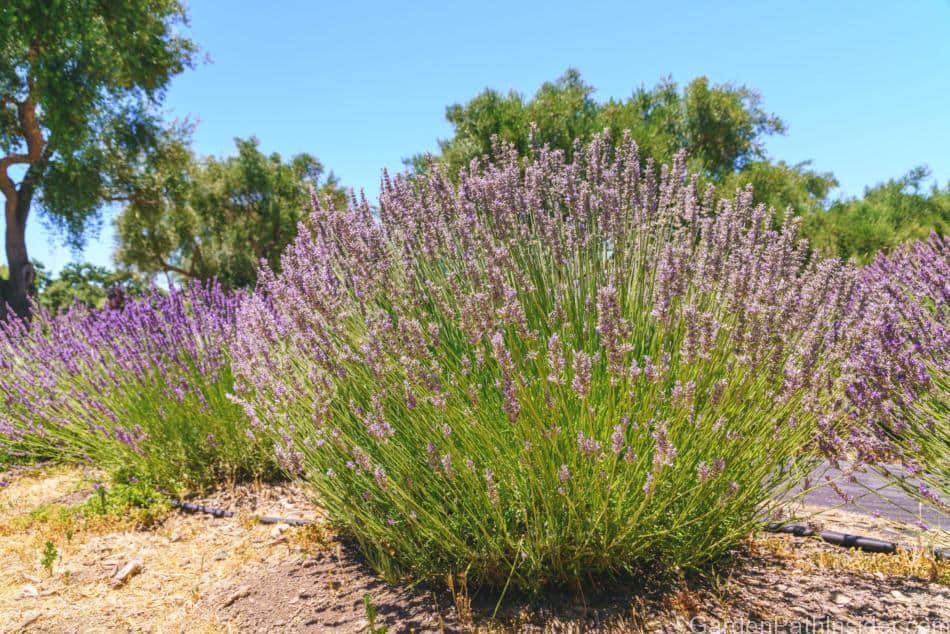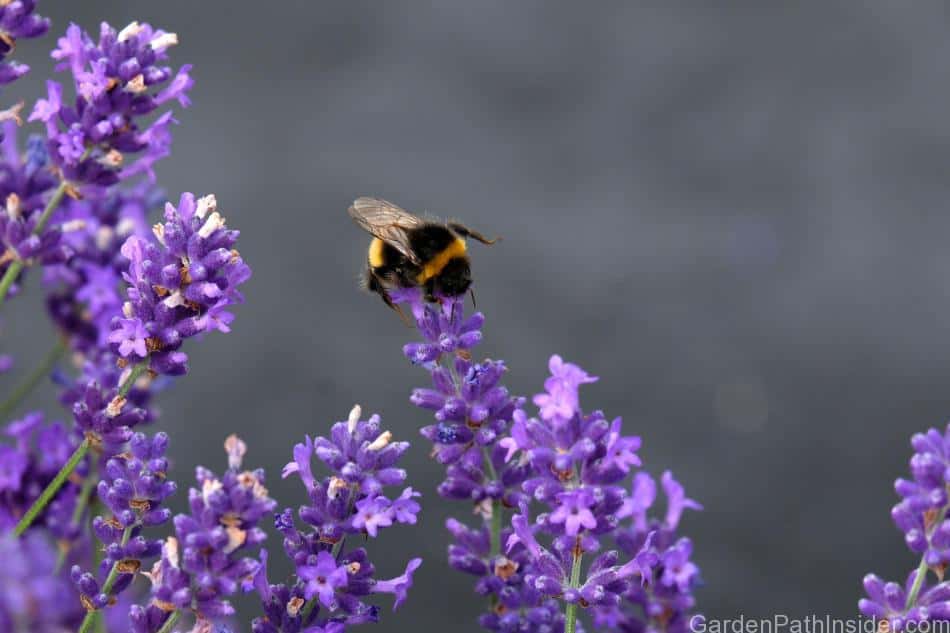
Learning how to grow lavender from seed will allow you to propagate any lavender plants in your garden. Growing lavender from seed also provides a larger variety of lavender species to choose from as unique varieties of lavender might only be available in seeds if a local nursery does not sell the desired variety.
You can grow lavender from seed to a mature plant in three steps:
- Germinate lavender seeds on a seed tray using sterile seed starting mix. Germination time: up to 1 month.
- Transplanting seed sprouts to small potting cartons or pots when the sprouts begin to grow leaves. May take up to 4 months to reach transplanting size.
- Transplant to a large pot or in the ground once seedlings grow 4 to 5 inches tall (10 to 12 cm).
- Read below for the full process breakdown.
How to Germinate Lavender Seeds
There are several methods of germinating lavender seeds listed below that can be used depending on the equipment you have available.
How to Germinate Lavender Seeds on Seed Trays
- On seed trays, spread a thin layer of well-draining fresh potting soil or sterile seed starting mix. The soil or seed starting mix will store water and maintain a moist foundation for the seeds to start germinating.
- On the thin layer of soil spread out lavender seeds leaving a small amount of space between the seeds to avoid restricted growth.
- Sprinkle a very thin top layer of fresh potting soil or sterile seed starting mix over the seeds.
- Water the seed tray with just enough water to dampen the soil. Overwatering will cause the seeds to rot and die.
- Store the seed tray in a warm location staying between 50°F and 70°F (10°C to 21°C). Place next to large sunny windows or under special growing heat lamps.
- Using this seed tray method, the seeds will start to germinate within a few days. However, it may take up to one month for the seed sprouting’s to be large enough to plant in small growing pots. This time frame is normal for lavender germination.
How to Germinate Lavender Seeds Using Paper Towel
To germinate lavender seeds in a paper towel you will need, lavender seeds, two pieces of paper towel, and a zip-close bag.
- Moisten two pieces of paper towel. The paper towel should be slightly damp. Too much water will cause the seeds to rot.
- Place several seeds on one of the moist paper towels, leaving a little space between each seed.
- Cover the seeds with the second piece of moist paper towel. The seeds should now be sandwiched between the two pieces of moist paper towel.
- Place the paper towel seed sheet carefully in a large freezer size zip bag; then close the bag fully.
- Place the bag in a warm location staying between 55°F and 75°F (12.7°C to 23.8°C) without direct sunlight.
- The seeds will start to germinate within a few days; it may take up to one month for the seed sprouting’s to be large enough to plant in small growing pots. This time frame is normal for lavender germination.
Can You Plant Lavender Seeds Directly in the Ground?

You can plant lavender seeds directly in the ground. Place the seeds on fresh well-draining soil, then lightly spread a thin layer of soil over the laid seeds. Do not cover the seeds with too much soil or they will not grow. Start the seeds in the ground in spring and keep the soil moist. Plant in full sun.
There are several advantages to germinating seeds in a controlled environment compared to the ground outside. When you plant small lavender plants that have established roots and are 4 to 5 inches tall (10 to 12cm) then the plant is much hardier and able to withstand the elements.
A young lavender plant will also have the advantage of utilizing the full growing season outdoors. Seeds can take several months from sprouting, to grow to a level that would be sustainable in the outdoor environment.
Refrigerate Lavender Seed Germination Method
- Place seeds on a damp paper towel set on a plate.
- Place the seed plate in a plastic zip-close bag.
- Place in the refrigerator for a month
- After a month place the still sealed plastic bag on a windowsill or near warm lights and begin the germination process.
- This method is used to simulate the cold dormant periods of the season to then help push the seeds into the warm sunlight growing phase post refrigerator.
How to Grow Lavender Seedlings
The lavender seedlings will be ready to transplant when the seedlings are roughly an inch long (2.5cm) and have developed several leaves. It may take up to a month for the seeds to grow large enough to transplant. First, prepare your growing trays and growing environment. Have these things ready to avoid touching and moving the delicate seedlings more than necessary.
Growing Trays
Growing trays come in many sizes and can be found online or at your local home store. Growing trays are normally sized by the number of growing cells per tray. A 72-cell growing tray can hold 72 seedlings.
Lavender Soil Needs
Lavender thrives in well-draining sandy soil. The seedlings will require special soil as the plants are still young and vulnerable to funguses and other diseases that may be in normal backyard topsoil. There are great potting soils you can buy online or at your local home store. Look for a potting soil that is designed for seedlings.

Transplanting the Lavender Seedlings
Step 1: Fill each cell on the seeding tray three-quarters full of well-draining fresh potting soil or sterile seed starting mix.
Step 2: Plant the seedlings deep enough that the fragile roots are fully covered, and the leaves do not rest on the soil. Use a small stick or tool to dig a small shallow hole in the soil. Once the seedling is in the hole, gently press the dirt around the stem to stabilize the small seedling. If you pack the soil too tight the roots will not be able to develop and spread through the soils.
Step 3: Water the soil as needed while the small lavender plants continue to develop their root system. Use just enough water to dampen the soil. Overwatering will cause the seeds to rot and die.
Step 4: How much sun do lavender seedlings need? Lavender seedlings need full Sun, 6 hours per day, or more. Take care to slightly rotate the growing trays clockwise every few days so all seedlings get equal sunlight exposure.
Once the seedlings have been transplanted to the growing trays it may take up to 4 months for the seedlings to develop into young hardy lavender plants able to withstand the weather and soil in an outdoor growing condition.
Transplant to a large pot or in the ground once seedlings grow 4 to 5 inches tall (10 to 12 cm). For more information read our article on growing lavender in pots.
How to Care for and Transplant Young Lavender Plants
Spring is the best time of year to plant lavender outdoors once the ground begins to warm up. Plan your growing calendar accordingly. Lavender may take four to five months to grow from seeds to a small plant that is hardy enough to plant outside in the ground.
Once the lavender is planted in a permanent garden bed or potted container, lavender requires little maintenance, it is not hard to grow lavender.
What Type of Lavender Seeds to Use
Lavender Lady is a popular seed to use when growing lavender from seeds because the seeds consistently grow to plants of roughly the same height and color.
In the past one of the main issues with starting with lavender seeds was a lack of consistency in appearance for the mature fully grown lavender. If you were growing a wildflower lavender garden in your backyard, the varying sizes and colors might not be an issue. If you are planting lavender borders in your yard the variation is not desired.
Modern lavender seeds are much better at producing plants with consistent features than they used to be. You can find several varieties of lavender seeds online or at your local home store.
Harvest Your Own Seeds
To harvest lavender seeds from your garden, start by taking flower cuttings from your lavender plants once they have reached full bloom. Tie the bundle of cuttings together and hang upside down to dry.
Once the flowers are dry, lavender seeds can be separated from the flower by lightly shaking the flowers into a bowl. The lavender seeds will fall from the flowers into the bowl. After the first round of seed shaking place the bundles of flowers upside down in a large paper bag. As the plant continues to dry the seeds will fall off into the bag.
Growing Lavender from Seeds VS. Growing Lavender from Cuttings
Consistency
Starting lavender plants from cuttings will produce an exact clone copy of the plant the cutting was taken from. The clone plant will grow to about the same height with the same colors and the same level and scent fragrance that the original plant had.
When you are growing lavender from seeds, there is always the possibility the seeds will grow slightly different from the parent plant. This is because the seeds on the parent plant are susceptible to genetic variation in offspring seeds/plants. Modern seeds have become much more consistent and can be used in any garden with confidence.

Time
Growing lavender from seeds can take up to 5 months in some cases before the seedling is ready to plant in its final garden bed plot or clay pot. Starting lavender from a cutting can take up to 3 months before a lavender cutting is ready to plant in its final growing location.
How to Grow Lavender Indoors
Growing lavender indoors has a few special requirements over growing outside. However, there are several advantages to growing lavender indoors as well. To learn more, read our post on growing lavender indoors.
Cover image: Purple lavender flowers_© batareykin/123rf.com
